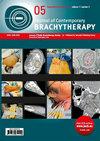Simple fabrication technique of personalized endocavitary brachytherapy applicator for maxillary alveolar cancer
IF 1.1
4区 医学
Q4 ONCOLOGY
引用次数: 0
Abstract
Purpose:We report on methods and outcomes of post-operative endocavitary brachytherapy after prior irradiation and salvage surgery in a patient with maxillary alveolar squamous cell carcinoma (SCC).
Material and methods:
A 67-year-old male with right maxillary alveolar SCC was referred for brachytherapy after prior definitive chemoradiotherapy and salvage posterior maxillectomy. A personalized endocavitary applicator was fabricated using dental impression plastic tray, vinyl polysiloxane paste, and four flexible catheters to deliver fourteen 3.5 Gy high-dose-rate fractions. High-risk and intermediate-risk clinical target volumes were treated to 3.7 Gy (D90) and 2.4 Gy (D98), with mandibular dose limited to 2.3 Gy (D2cc) per fraction. These corresponded to total 2 Gy equivalent doses (EQD2) of 72.8 Gy, 40.5 Gy, and 34 Gy, respectively.
Results:
The patient developed grade 2 mucositis and was disease-free for six months. He had biopsy-confirmed local recurrence at 8 months. He refused further treatment and expired within a month.
Conclusions:
This simple approach to a personalized endocavitary applicator is feasible and allows for lower costs and less treatment delays, while ensuring patient comfort and convenience.
上颌牙槽癌个性化腔内近距离放射治疗器的简单制造技术
材料和方法:一名67岁的男性患者患有右上颌骨齿槽鳞状细胞癌(SCC),在接受了明确的化放疗和后上颌骨切除术后转诊接受近距离放射治疗。我们使用牙科印模塑料托盘、乙烯基聚硅氧烷糊剂和四根柔性导管制作了一个个性化腔内涂抹器,可提供 14 个 3.5 Gy 高剂量率分段。高危和中危临床靶区的治疗剂量分别为 3.7 Gy (D90) 和 2.4 Gy (D98),下颌骨剂量限制为每分 2.3 Gy (D2cc)。结果:患者出现了2级粘膜炎,6个月无症状。8 个月后,活检证实局部复发。结论:这种个性化腔内涂抹器的简单方法是可行的,可以降低成本,减少治疗延迟,同时确保患者的舒适度和便利性。
本文章由计算机程序翻译,如有差异,请以英文原文为准。
求助全文
约1分钟内获得全文
求助全文
来源期刊

Journal of Contemporary Brachytherapy
ONCOLOGY-RADIOLOGY, NUCLEAR MEDICINE & MEDICAL IMAGING
CiteScore
2.40
自引率
14.30%
发文量
54
审稿时长
16 weeks
期刊介绍:
The “Journal of Contemporary Brachytherapy” is an international and multidisciplinary journal that will publish papers of original research as well as reviews of articles. Main subjects of the journal include: clinical brachytherapy, combined modality treatment, advances in radiobiology, hyperthermia and tumour biology, as well as physical aspects relevant to brachytherapy, particularly in the field of imaging, dosimetry and radiation therapy planning. Original contributions will include experimental studies of combined modality treatment, tumor sensitization and normal tissue protection, molecular radiation biology, and clinical investigations of cancer treatment in brachytherapy. Another field of interest will be the educational part of the journal.
 求助内容:
求助内容: 应助结果提醒方式:
应助结果提醒方式:


